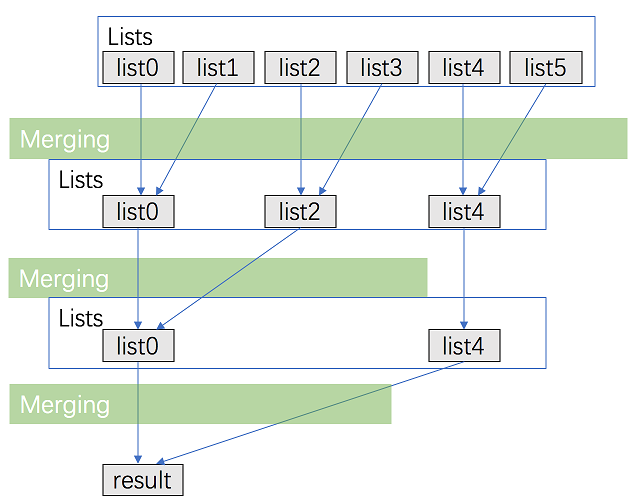本文最后更新于:2022年4月9日 中午
给你一个链表数组,每个链表都已经按升序排列。
请你将所有链表合并到一个升序链表中,返回合并后的链表。
示例 1:
| 输入:lists = [[1,4,5],[1,3,4],[2,6]]
输出:[1,1,2,3,4,4,5,6]
解释:链表数组如下:
[
1->4->5,
1->3->4,
2->6
]
将它们合并到一个有序链表中得到。
1->1->2->3->4->4->5->6
|
示例 2:
示例 3:
提示:
k == lists.length0 <= k <= 10^40 <= lists[i].length <= 500-10^4 <= lists[i][j] <= 10^4lists[i] 按 升序 排列lists[i].length 的总和不超过 10^4
Solution
参考 LeetCode官方
- 顺序合并
- 借助两个链表合并的思想
- 时间复杂度 O(k^2^ n),空间复杂度 O(1)
1
2
3
4
5
6
7
8
9
10
11
12
13
14
15
16
17
18
19
20
21
22
23
24
25
26
27
28
29
30
31
32
33
34
35
36
37
38
39
40
41
42
43
|
class Solution {
public:
ListNode* mergeKLists(vector<ListNode*>& lists) {
if(lists.size()==0)
return nullptr;
ListNode* ans = nullptr;
for(int i=0; i<lists.size(); ++i){
ans = mergeTwoLists(ans, lists[i]);
}
return ans;
}
private:
ListNode* mergeTwoLists(ListNode* a, ListNode* b){
if(!a || !b) return a ? a: b;
ListNode* dummyHead = new ListNode(-1);
ListNode* cur = dummyHead, *aPtr=a, *bPtr=b;
while(aPtr && bPtr){
if(aPtr->val < bPtr->val){
cur->next = aPtr;
aPtr = aPtr->next;
} else {
cur->next = bPtr;
bPtr = bPtr->next;
}
cur = cur->next;
}
cur->next = (aPtr ? aPtr : bPtr);
return dummyHead->next;
}
};
|
- 分治合并
- 时间复杂度 O(kn * log k),空间复杂度 O(log k)

1
2
3
4
5
6
7
8
9
10
11
12
13
14
15
16
17
18
19
20
21
22
23
24
25
26
27
28
29
30
31
32
33
| class Solution {
public:
ListNode* mergeKLists(vector<ListNode*>& lists) {
return merge(lists, 0, lists.size()-1);
}
private:
ListNode* merge(vector<ListNode*>& lists, int l, int r){
if(l==r)
return lists[l];
if(l>r)
return nullptr;
int mid = (l+r) >> 1;
return mergeTwoLists(merge(lists, l, mid), merge(lists, mid+1, r));
}
ListNode* mergeTwoLists(ListNode* a, ListNode* b){
if(!a || !b) return a ? a: b;
ListNode* dummyHead = new ListNode(-1);
ListNode* cur = dummyHead, *aPtr=a, *bPtr=b;
while(aPtr && bPtr){
if(aPtr->val < bPtr->val){
cur->next = aPtr;
aPtr = aPtr->next;
} else {
cur->next = bPtr;
bPtr = bPtr->next;
}
cur = cur->next;
}
cur->next = (aPtr ? aPtr : bPtr);
return dummyHead->next;
}
};
|
- 利用优先队列
- 维护当前每个链表没有被合并的元素的最前面一个,k 个链表就最多有 k 个满足这样条件的元素,每次在这些元素里面选取
val 属性最小的元素合并到答案中。
- 时间复杂度 O(kn * log k),空间复杂度 O(k)
1
2
3
4
5
6
7
8
9
10
11
12
13
14
15
16
17
18
19
20
21
22
23
24
25
26
27
28
29
| class Solution {
public:
struct Status
{
int val;
ListNode *ptr;
bool operator < (const Status &rhs) const{
return val > rhs.val;
}
};
priority_queue<Status> pq;
ListNode* mergeKLists(vector<ListNode*>& lists) {
for(auto node: lists){
if(node)
pq.push({node->val, node});
}
ListNode* dummyHead = new ListNode(-1), *cur = dummyHead;
while(!pq.empty()){
auto S = pq.top();
pq.pop();
cur->next = S.ptr;
cur = cur->next;
if(S.ptr->next)
pq.push({S.ptr->next->val, S.ptr->next});
}
return dummyHead->next;
}
};
|
